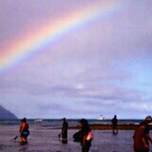
Hawaiian 'āina(land)-based education
My PhD research (2012-13) involved collaborative ethnographic research at the Hawaiian-focused charter school Kanuikapono, where I served as visual media instructor to the high school students. My research was guided by my Master's research at other Hawaiian-focused charter schools on the central role of keiki (children) for revitalizing Hawaiian-specific knowledge within their families, including the language, protocol, and other practices, like planting kalo (taro), dancing hula, or paddling the wa'a (canoe). At Kanuikapono, I taught high school students photography, film and editing for them to tell their own stories of relating to the 'āina, or what is colloquially translated as land (it also encompasses the ocean, as well as people dwelling in these ecosystems).
The context of the agricultural biotechnology industry on Kaua'i added another political dimension to the already complicated history and presence of settler colonialism. For some decades, Hawai'i has been a prime location for researching and developing genetically engineered and hybrid crops, and at the time of my fieldwork this circumstance led to many public protests. What emerged in these debates were continuous assertions of different actors - proponents and opponents of the industry, settler and Kānaka Maoli - to properly 'get educated' on GMOs, land relations and food production.
In my dissertation, I explore the notion of education in detail, suggesting that its norms and practices have long left institutional settings (like a school) to mean various things, from asserting Indigenous rights to self-determination, public deliberations over biotechnology, to a corrective effort of public misconceptions of biotechnology by industry representatives. Through the notion of learnscapes, I offer an extended understanding of 'education' which is too often presumed to be a fixed thing that does not account for the highly diverse lived experiences of people that assert and practice it.
Below is a Visual Vignette that I created as a threefold handout which I gave to people that participated in my research project at a follow-up visit in 2019. It was a way for me to share what I had written in 350 pages, without them having to read 350 pages. A forthcoming chapter in Unsettling Technoscience (University of Toronto Press) will also feature this research study.
























